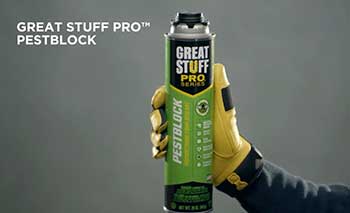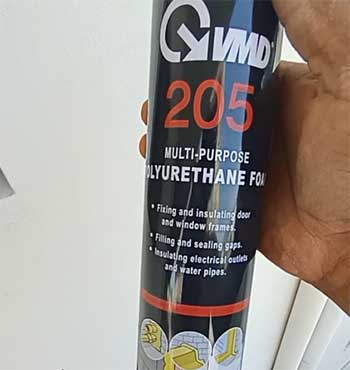Pests like mice, rats, insects and more can be a real nuisance in your home. Not only are they unhygienic, but they can cause serious structural damage by chewing through walls, floors, and ceilings. Using pest control foam is an effective way to seal up entry points and prevent pests from getting in.
But should you use regular expanding foam or pestblock foam specifically designed for pest exclusion? Here’s an in-depth look at pestblock and regular foam so you can decide which is better for your needs.
A Brief Comparison Table
| Feature | Regular Foam | Pestblock Foam |
| Pest repellent abilities | None | Contains bittering agents and additives to deter pests |
| Strength | Can be chewed through by rodents | Highly resistant to chewing and gnawing once cured |
| Durability | Prone to damage from pest gnawing | Withstands pest chewing attempts better |
| Cost | Lower | 20-50% more expensive due to special additives |
| Odor | Minimal odor | Strong bitter smell dissipates after 1-2 days |
| Applications | General sealing and insulating | Specialized pest control and exclusion |
| Curing time | 12 hours | 12 hours |
| Permanence | Difficult to remove completely once cured | Difficult to remove completely once cured |
| Flammability | Flammable while curing | Flammable while curing |
What Is Pestblock Foam?
Pestblock foam is a polyurethane-based spray foam that has been fortified to make it extra resistant to chewing and gnawing damage from rodents, insects, and other pests.
Popular brands like Great Stuff Pestblock contain a bittering agent that makes the foam unpalatable to common household pests. It dries hard as a rock and is impenetrable once fully cured.
Pestblock foam is ideal for sealing up cracks, holes, gaps, and other openings that may allow pests to enter. It can be used both indoors and outdoors. The foam expands as it cures, allowing it to fill spaces thoroughly and form a long-lasting barrier.
Unlike regular foam, pestblock foam has undergone specialized testing to ensure pests cannot eat through it.
Pros Of Using Pestblock Foam
There are several benefits that make pestblock foam a smart choice over regular foam when dealing with pest exclusion projects:

- Pest Repellent: The bitter taste deterrent added to pestblock foam makes it unpleasant for pests to chew through. Mice, rats, squirrels and more will avoid gnawing on cured pestblock foam.
- Durable: Pestblock foam is highly resistant to damage caused by pest gnawing and chewing. It holds up better than regular polyurethane foam.
- Long Lasting: Once fully cured, pestblock foam maintains its solid structure for years. It provides a permanent, long term pest exclusion solution.
- Expands to Fill Gaps: Just like regular foam, pestblock foam expands as it cures, letting it fill gaps thoroughly and leave no room for pests to squeeze through.
- Bonds Tightly: The foam adheres tightly to most common building materials like wood, metal, masonry, glass and more to create a tight seal.
- Quick Application: Pestblock spray foams allow for quick and easy application to block pest entry points. No major construction work is required.
Also Read: Choose Between Great Stuff Pestblock And Gaps And Cracks.
Cons Of Pestblock Foam
While pestblock foam has many benefits for keeping pests at bay, there are a few potential drawbacks to consider:
- Higher Cost: Pestblock foam tends to cost more than regular polyurethane foam, given the specialized additives it contains. Expect to pay 20-50% more.
- Temporary Odor: The foam may have a strong bitter chemical smell for the first 24-48 hours as it cures. The scent dissipates over time.
- Messy Applications: Like regular foam, pestblock foam can get messy if you’re not careful. It will stick to skin, clothing and surfaces.
- Curing Process: Pestblock foam takes around 12 hours to fully cure and harden. The area should not be disturbed during this time.
- Permanent: Removing cured foam is difficult, so precise application is important. Consider removable caulk for non-permanent needs.
- Flammability: The foam is flammable until it fully cures. Avoid heat/flames during application and curing.
Types Of Pestblock Foam
There are a few different forms of pestblock foam products available:
- Spray Foam: Pestblock spray foam (such as Great Stuff Pestblock) allows you to spray the foam directly into cracks and openings. This is the most popular and cost-effective option.
- Injectable Foam: Pestblock injectable foam products come with a narrow nozzle for inserting into especially small openings and filling them from the inside out.
- Pre-Formed Foam: Pre-formed pestblock foam comes ready to use in sheets, strips or tubes. It gets inserted or pressed into place. Less mess, but more expensive.
- Foam Sealants: Some caulk-like sealants contain pestblock additives. These are useful for smaller gaps and non-permanent applications.
Also Read: Is Thermacell Enhanced Better Than Legacy?
What Types Of Pests Can Pestblock Foam Deter?
Pestblock foam is highly effective at deterring the most common nuisance pests. These include:
- Mice: Mice will avoid chewing through cured pestblock foam due to its bitter taste. Properly sealing all entry points keeps mice out.
- Rats: Like mice, rats are repelled by the bitter flavor and cannot gnaw through strong pestblock foam once it hardens.
- Squirrels: Squirrels can be extremely destructive pests but are unable to eat through pestblock foam barriers. Sealing attic entry points is key.
- Raccoons: Raccoons are stubborn pests but the durable pestblock foam withstands their gnawing and deters entry.
- Bats: Fill potential openings like soffits, vents and chimneys with pestblock foam to repel bats.
- Insects: Cured foam stops insects like ants, cockroaches, spiders and more by eliminating cracks and crevices they use to enter.
- Snakes: Snakes can’t slither through openings sealed up with expanding pestblock foam.
- Birds: Block access to nesting and roosting spots by filling openings with long-lasting pestblock foam.
As you can see, pestblock foam keeps most problematic pests out of homes and buildings when applied correctly. The bitter taste and durability combine to deter pest chewing and damage.
How To Apply Pestblock Foam
Applying pestblock foam correctly is important to create an effective pest barrier. Follow these tips:
- Identify all potential pest entry points on the interior and exterior. Look for cracks, holes, gaps around pipes and vents, where walls meet floors/ceilings, etc.
- Clean and dry all surfaces thoroughly where the foam will be applied. For best adhesion, roughen smooth surfaces first.
- Wear gloves and eye protection. Cover nearby surfaces like floors since the foam can spread and drip.
- Follow all safety instructions on the foam packaging. Use in a well-ventilated area.
- Shake the spray foam can vigorously before use. Insert the applicator straw firmly.
- Fill gaps no more than 1/3 full, allowing room for expansion as the foam cures.
- Dispense foam slowly and carefully to minimize mess and avoid excess.
- Let foam fully cure for at least 12 hours before disturbing. Trim off any excess dried foam with a sharp knife.
- Look for any additional gaps and re-apply as needed until all entry points are thoroughly sealed.
Taking the time to properly identify and seal pest entry points with pestblock foam will provide long-lasting pest exclusion and peace of mind.
Pestblock Foam Vs. Regular Foam: Key Differences
Pestblock and regular polyurethane foam share some similarities, but also have some key differences that are important to recognize:

- Pest Repellent Ability: Pestblock foam contains deterrents like bittering agents. Regular foam lacks these protective additives.
- Strength: Pestblock foam cannot be eaten through by pests once cured. Regular foam is easier for pests to compromise.
- Durability: Fortified pestblock foams withstand pest chewing and damage better than standard polyurethane foam.
- Cost: Due to specialized formulations, expect pestblock foams to cost 20-50% more than regular expanding foam.
- Odor: Pestblock foam may have a stronger odor initially as the bittering agent dissipates.
- Applications: Both work well for sealing cracks, gaps, and blocking openings. Pestblock foam offers added pest resistance.
- Curing: Both standard and pestblock foam cure in about 12 hours. The curing process is very similar.
While regular foam has its uses, pestblock foam is undoubtedly the superior choice when it comes to excluding pest animals and insects from a structure through permanent, chew-resistant seals. The enhanced durability and deterrent abilities give pestblock foams a clear advantage.
Pestblock Foam Vs. Other Pest Control Methods
Foam exclusion products like pestblock foam offer several benefits over other pest control techniques:
Vs. Poison Baits/Traps: Foam seals keep pests out mechanically/physically unlike baits and traps that attempt to kill pests after entry. There’s no dead pest cleanup.
Vs. Pesticides: Sealing with foam means you avoid the hazards, smells and hassles associated with spraying pesticides. Foam is lower risk.
Vs. Fumigation: Foam sealing provides effective long-term prevention without dangerous fumes required for fumigation. Much safer for homes.
Vs. Wood/Steel: Physically blocking holes with wood, steel wool, hardware cloth etc. is time consuming. Foam insulation offers quicker, cleaner permanent seals.
Vs. Caulk: While caulk can work for smaller gaps, foam offers superior filling for larger spaces. Foam also adheres better and lasts longer.
Vs. Cement: Sealing outdoor holes in foundations, etc. with cement is permanent but extremely labor intensive compared to easy foam applications.
When weighing various pest control options, foam barriers provide an excellent balance of safety, effectiveness, and ease of use in most situations. The special durability of pestblock foam makes it ideal for keeping pests at bay over the long run.
Also, watch the video about Pestblock Foam!
Frequently Asked Questions (FAQ)
Yes, pestblock foam is extremely effective at both blocking and deterring pests when applied correctly. The bitter taste repels pests while the durable polyurethane foam cannot be chewed through when hardened. Sealing all possible entries thoroughly keeps unwanted pests out.
Pestblock foam works extremely well to exclude mice. Mice are unable to gnaw through the cured foam due to its strength and bitter flavor. Ensure all tiny openings mice can enter are adequately sealed with pestblock foam for best results. The foam provides a permanent, mouse-proof barrier.
No, mice cannot chew through cured Great Stuff brand Pestblock foam once it fully hardens. Great Stuff Pestblock contains bittering agents that deter mice and its durable polyurethane foam formulation is impenetrable. When applied properly into all potential mouse entries, Great Stuff Pestblock provides long-term mouse exclusion and protection.
Pestblock spray foams typically take around 12 hours to fully cure, harden and become chew-proof to pests. The foams should not be disturbed while curing. Most foams are tack-free in 1-2 hours but still require the full 12 hours to reach maximum strength and pest resistance. Confirm exact cure times on the product’s instructions.
Also Read: Differences Between Ecoshield And Terminix.
Conclusion
When you need permanent, pest-proof seals around your home or building, pestblock spray foam is the best choice over regular polyurethane foam. Pestblock foam deters pests thanks to its bitter taste, and its durable matrix withstands chewing, gnawing and damage once hardened.
While regular foam works fine for general insulation and air sealing purposes, pestblock foam’s specialized abilities give it a clear advantage for true pest exclusion and prevention. Investing in pestblock foam means you can block pests at the source while avoiding the hassles and risks of other pest control methods.
With robust pestblock foam barriers installed properly in all vulnerable areas, you can rest easy knowing your property is secured against invasive mice, rats, squirrels and more.
